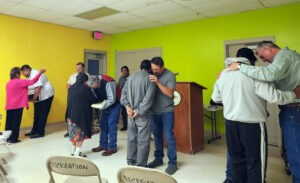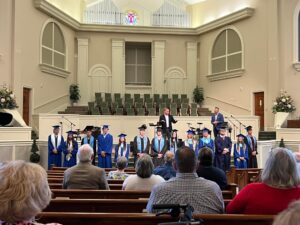
WILLIAMSBURG, Ky. (BP)–His head recently went bald, evidence of a renewed bout with malignant lymphoma. But the Southern Baptist pastor who organized the nation’s largest cross museum finds comfort in knowing his accomplishment will outlive him.
“We all want our life to have some permanence beyond our years on earth,” said Robert Williams, who retired from the pulpit 10 years ago but does supply preaching. “It gives me a good feeling to know I’ve done something that will be here after I’m gone. A lot of people don’t have that opportunity.”
The Carl Williams Cross Museum is the outgrowth of a hobby that began several decades ago. It is named after his late son, a pastor who died in an accident in 1981. While Robert maintained the collection for a while in a storefront operation in downtown Louisville, Ky., several years ago he donated it to Cumberland College, Williamsburg, Ky., a Christian college that receives a portion of its funding from the Kentucky Baptist Convention.
The college has since hosted a pair of conferences on the cross which drew attendees from across the nation. More than 5,000 people visit the museum annually, and information about it appears on the school’s Internet site (www.cumber.edu).
Bob Dunston, chairman of Cumberland’s religion and philosophy department, said the collection reinforces the college’s Christian identity and lets the public know what values are important to their educational process.
“It gives me an opening in Christian history class and to have students involved in research on the cross and symbolism in the church,” he said. “Having a museum and a place to do research says a lot about a college. Not only do we want to train students, but we want to link them to the past and create information to move into the future.”
More than 7,100 crosses and crucifixes fill the museum, along with paintings, drawings, photographs, carvings, candles, communion trays and Bibles.
The crosses include a number owned or fashioned by Williams, a craftsman and self-described “trader” who still uses sales from a Louisville flea market to help generate funds for the museum. There’s the chaplain’s cross he received while serving in the United States Air Force in the early 1950s. And a wooden cross he made from an old kitchen counter at one of the churches he pastored. His favorite is a six-foot-tall cross he made by welding metal scraps together.
Meanwhile, the far-ranging variety of crosses in the museum come from places like Ireland, Honduras, Peru, Germany and Czechoslovakia. There is a crystal cross from Russia, which was donated by two Southern Baptist missionaries there, and a dark-colored Russian Orthodox item with two holes in it. Approximately 200 years old, Williams believes the holes were made from bullets.
The collection includes some unique selections — and stories behind them.
There is a small cross tipped in gold which came from Alabama’s Libby Prison, an 1863 Civil War heirloom donated by one family. The only place gold could have come from in those circumstances was someone’s teeth, Williams said.
Inmates from a state prison about 20 miles north of Louisville contributed two of the most unusual. One features a man crumpled near the base of the cross with a ball and chain nearby, leading Williams to note, “There’s a lot of symbolism in these crosses. You’ve got to look beyond the surface.”
The other reflects the state’s tobacco heritage — it was made from portions of Camel cigarette packs. Its creator contacted Williams for help upon his release. Responding to the plea, the pastor found him an apartment and secured a job interview. But the next morning, Williams found the apartment was vacant. Ironically, the ex-prisoner left behind a book titled, “Vanished.”
“You don’t regret doing that,” he chuckled about the disappointment. “You’ve got to try, but it’s up to the individual to make the effort. I would have driven to [the prison] just to get the cross.”
Despite the large number, the collection isn’t the world’s largest. That distinction belongs to Ernie Rada of San Jose, Calif., who recently was notified his 8,400-plus inventory had made the Guinness Book of World Records. However, it’s in Rada’s garage because he hasn’t been able to find financial backing for a museum.
Besides, Williams said his goal is not enlarging his collection, but to begin cataloging and explaining it. A museum should be an interpretive center, he said, not simply a collection of things.
That said, he is trying to decide how to mark some controversial items, such as a cross pin once used by the rock group Black Sabbath and another that belonged to astrologer Jeanne Dixon.
“I wanted to deal with controversial items rather than ignore them,” Williams said, “to help people see that some, like rock groups, misuse the cross. And Jeanne Dixon. Are you going to look to astrological signs or God? But I haven’t figured out how to put a sign up there saying, ‘This is inappropriate.’”
There are three reasons for an emphasis on the cross, the veteran pastor said. It serves as a reminder of what God did for us, it acts as a witness to faith and it serves as a challenge to live as Christ did, he explained.
As the cross-stitch hanging on a museum wall reminds, “God gave us the cross. The cross gives us God.”















